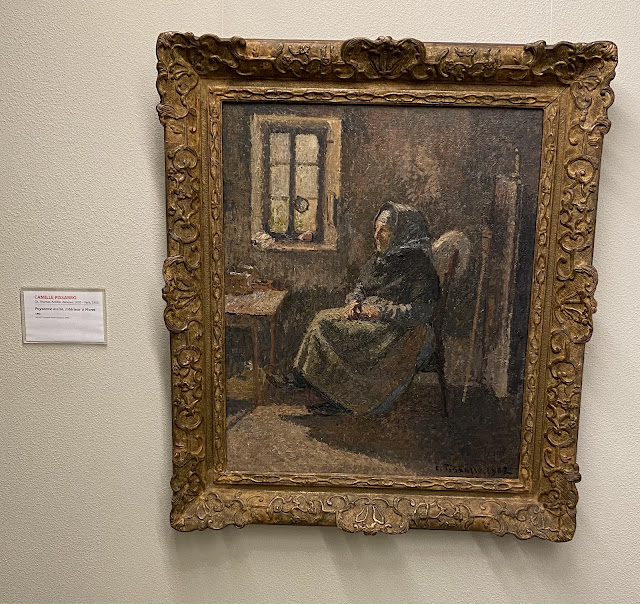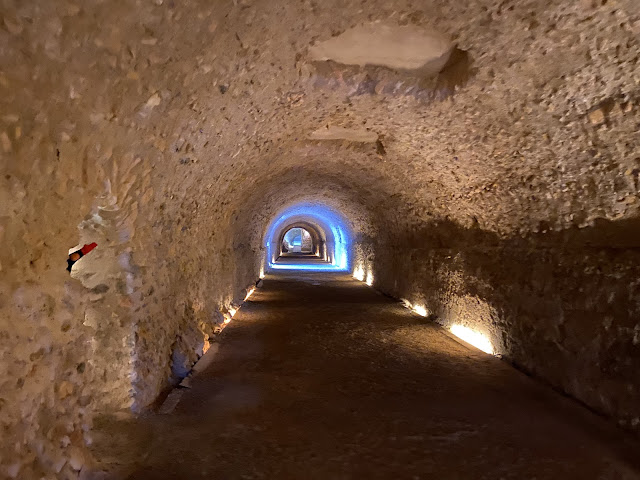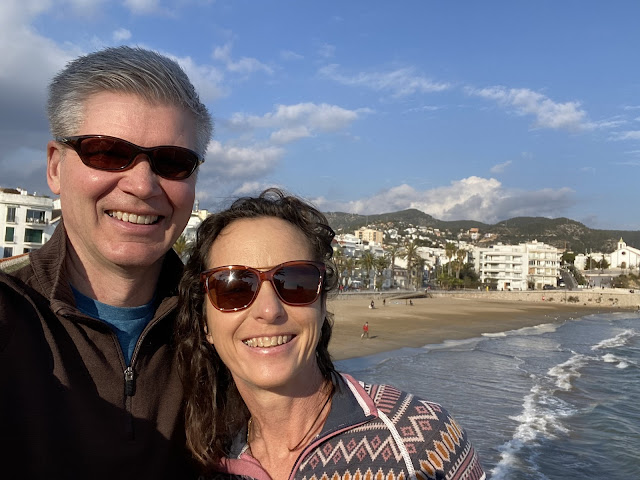Moving to the Country, Gonna Eat a Lot In Sitges
First, a word about today's title. We wanted to write something that would help you to pronounce the name of the city we’re in (just as we did with ‘Reimes rhymes with France). If you’re not familiar with the song by The Presidents of the United States of America called ‘Peaches’, do yourself a favour and have a listen. And once we learned that the lyrics from Peaches were (maybe) referencing John Prine’s 1972 song “Spanish Pipedream,” well – our choice was made for us.
We’re still working on names for her/him, but I can tell you
it definitely won’t be prefaced by ‘Big’. Which is probably just as well, because
parking spots in Spain tend to be on the small side. Like, pull your mirrors in
before you park small. But, despite his diminutive size, Little Simba (? maybe?
let’s try that name on for size) still managed to swallow our two sets of golf clubs,
two knapsacks and a couple of daypacks without
complaint. Swallowing Al in the driver’s seat was a little more challenging, but
nothing that a good neck specialist can’t fix later.
 |
| Things went sharply downhill from here |
A couple of days after arrival, Al and Al went out and
played golf with a couple of Al’s friends (Do you see how confusing this was)
for the weekly ‘Silver Foxes vs Baldies’ match. No guesses on which team this
Al slotted into. I’m sad to report that the Silver Foxes, despite being up by 4
holes early, gave them all back on the back 9, eventually losing the match on
the 18th green with a putt that went wide right.
 |
| This was not my reaction to missing that last putt. |
Cau Ferrat Museum and Museu de Maricel
While Al
was off playing golf, Michelle took in some of the local art. Perched on the
edge of the Mediterranean, is the Cau Ferrat Museum and Museu de Maricel within
the home built in the late 19th century by a local artist, Santiago Rusiñol. The
small house itself was quite amazing in itself and then you arrive on the second
floor to find a huge, cathedral-like room filled with his collection of ‘stuff’
including about thirty wrought iron candelabras, just as many door knockers,
and the list goes on. These days he’d be close to being labelled a hoarder. But
apparently he preferred to be known as a collector.
Montserrat
One of the magical things about modern cameras is that they
can make even the plainest of days look downright spectacular. Weather here in
Spain hasn’t been anything to write home about (although here we are, writing home
about it). It’s been a mixture of sun and clouds (at best), or wind and rain
(at worst). But, the worst day on holiday is still better than the best day at
work, so there is no complaining here at all. We took a day trip up to Montserrat,
which is a nearby mountain with a monastery clinging to the side of it. Mons Serratus
in latin means ‘Saw Toothed Mountain’, and in Catalan Montsagrat means ‘Sacred
Mountain’, which seems a nice confluence of language to have a Benedictine
Monastery placed in these very unusually shaped pinnacles.
As well as the splendour that was the monastery and the nature, there’s also a 'modest' art gallery at Montserrat that is well worth a visit. Along with some local Spanish artists of both recent and ye olde variety, the gallery pulls out a few surprises such as a Pisarro or two, a couple of Picassos, and some Egyptian plunder I mean discoveries including a couple of mummies.
 |
| Pisarro |
 |
| I love the level of expression achieved with just a palette knife |
 |
| Picasso was FIFTEEN when he painted this. |
 |
| So cool how the artist achieved a crowd scene using just blobs of paint. I felt like Cameron in Ferris Bueller. |
 |
| Montserrat a hundred years ago looks alot like Montserrat today. |
Sitges is a seaside town surrounded by a low range of mountains,
a lot of which is reserved as Garraf national park. with a look and feel that reminded
us of the hills around LA.
 |
| View from our rooftop balcony. TBH we didn't go up there much because... March... |
 |
| Not what the beach is like in summer, I'm assured! |
E-bikes to the monastery, and a huge meal
With all the entrepreneurial people in Sitges (read as: people
doing whatever they can in order to live in a Spanish beach town), it wasn’t surprising to hear someone had recently
set up an e-bike store on the edge of the national park, where you can rent e-bike
and then after the ride stop by for a coffee and snack in their cool café.
 |
Somewhat to the disappointment of at least one of Ali’s
friends, these were the e-assist kind of e-bike, which means you still have to pedal
(Ed: the other type of e-bike is… a motorbike). Those who had visions of effortlessly
gliding up the hill, suddenly started to worry that this might actually require
some exertion. But not to worry, as soon as we got on, we were immediately
pushed forward with only minimal leg power required.
 |
| The best thing about an e-bike: It looks like you’re exercising, but you’re not. |
So we headed off in search of some unsealed roads and a path through the forest. After about an hour we were suddenly out of the hills and on the edge of a small gathering of buildings, including a Buddhist monastery. Not exactly what we were expecting at the top of a hill in the Spanish countryside!
 |
| Liquid Courage for all that 'exercising' |
Herbias liqueur (yerba), a bright yellow concoction infused with herbs. Not suprisingly, attributed to the monks in Ibiza. Descriptions ranged from ‘warming’ through to cough medicine, Al was not a fan and opted for limoncello.
Stage 2 of the afternoon was a long lunch in a former
hunting lodge within the forest. After twice as many calçots as we could manage,
grilled meat of all descriptions and a good dose of cava and vino tinto, we rolled
out of there three hours later. A good Spanish lunch.
 |
| Pa amb Tomaquet (See below for an explanation!) |
 |
| Wabbit! This meal may have been what inspired this blog's title |
 |
| If you look carefully you can see the Med behind us. |
A short
drive south of Sitges is a a town called Tarragona which it turns out was the capital
of the ancient Roman area that now makes up about two thirds of Spain. It’s not
just Roman ruins that are on display here because, like all of Spain this city
has seen many different cultures and religions come and go.
 |
| On the way to Tarragona, we stumbled across another aqueduct. |
The Roman amphitheatre,
built in the second century right next to the beach, saw its fair share of gladiators
before the Visigoths arrived and started to dismantle the amphitheatre so they
could use the stones to build a basilica. This was replaced by a convent and then
a prison.
 |
| A corridor of the circus running below the existing city streets |
 |
| They estimate this would have been 15m high! |
 |
| One view from the top of the tower. It was 360 degrees of spectacular |
 |
| View to the cathedral from the tower |
 |
| Another day, another thick city wall. |
Wine Tasting in Priorat
We had planned to head directly from Sitges to Valencia, but
after tasting some of the local wine we decided a visit to the local wine
region to learn more about the local vino tinto was in order. The area around Barcelona
and Sitges produce the majority of the world’s Cava and we can attest that they
do a good job. A little further south, in the mountains inland from Tarragona
can be found the Priorat (DOCQ) and Monsant (DOC) wine regions.
It was the monks who first started making wine here in the
12th century. Just as well as no one else would be likely to look at
these steep, dry hills and think ‘yep, this looks like a good place to grow,
tend and harvest grapes’. And when we say steep we don’t mean a slight upward
incline, we mean ‘I’m finding it hard to stay upright’.
 |
| Not a good representation of the steepness. But this will have to do. |
According to Jaume, who led our wine tasting, it wasn’t
until the 90’s that the wineries in Priorat actually started to produce wine that
was, and we quote directly here, ‘even drinkable’. At that point they established
a local wine school, started using more modern wine making methods (and possibly
brought in some good marketers). And today it’s come full circle, as it’s the wines
that use the traditional methods that fetch the highest prices. Though we
enjoyed all of it.
Favourite food finds from Sitges.
It would not be a Broom blog
post without mention of food.
Pa amb Tomaquet, Tomato bread. Walk into any tapas bar in Catalonia and they will serve you their version of this bread. But it’s way more fun to do it yourself like we did at the hunting club lunch. At family lunches, Catalans will start a meal by serving toasted bread and a bowl with ripe tomatoes and fresh garlic. Rub the garlic clove on the toast, squeeze the tomato in your hand and spread it on the bread then drizzle with olive oil. Fun with food!
























Comments
Post a Comment